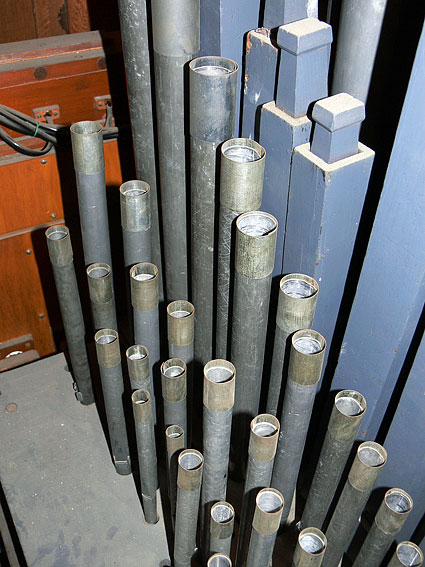Brunswick Baptist Church
Sydney Road, Brunswick
B 1880 Gray & Davison, London for St Pancras Old Church, London (job no 10423);
rem 1926 Hill, Norman & Beard & exported to Melbourne;
inst present loc 1929 Frederick Taylor; reb 1952 Hill, Norman & Beard (o/n V262);
ren 1975 Geo Fincham & Sons. 2m, 19spst, 7c, elpn.
Gt: 16.8.8.8.4.4.2.II. Sw: 8.8.8.4.2.8.8. Ped: 16.16.8.4.


The history of the Brunswick congregation dates back to 1862. The foundation stone of the present church was laid on 30 May 1889. The building remains substantially intact and is discreetly located among the facades of the adjacent shops and next to an attractive Queen Anne style building, with projecting bays and boarded gables (possibly designed by the noted partnership of Ussher & Kemp), built in 1898 as a dental surgery and house for Dr F.W. Kiel and now owned by the church.
The church is constructed from brown and cream brick with cement dressings and has an attractive façade facing Sydney Road. It incorporates three blind Gothic arches, with banded voussoirs, five rows of cream brick banding, an arcaded porch and a three-light Perpendicular Gothic window placed above. The building consists of a six-bay nave, an unusual feature being the small circular clerestory windows which can be swung to permit internal ventilation. The architect of this delightful example of late-Victorian church architecture has been impossible to find.
The interior has a raked floor, with two aisles. There is a rear gallery supported on cast iron columns. The roof trusses are of distinctive design and incorporate a quatrefoil motif. There are also oversize ventilating panels of Gothic design let into the boarded ceiling.
The interior woodwork includes pews with distinctive ends incorporating columns and a decorative inlaid motif with applied circular discs. These appear to be related stylistically to those in The Scots' Church in the City. The carved blackwood pulpit was installed in 1929 in memory of Elizabeth Robilliard.
The glass entirely consists of the original quarries set in colourful borders, these mainly in reds and blues. These were possibly supplied by Ferguson & Urie.
The organ was built by the notable London organbuilding firm of Gray & Davison in 1880 for St Pancras Old Church, St Pancras Way, Somers Town, London as the firm’s job number 10423. St Pancras is one of the oldest places of Christian worship in Britain. The specification of this organ, from the National Pipe Organ Register, was recorded in 1919:
| GREAT Open Diapason Stopped Diapason Dulciana Principal Flute Fifteenth Mixture Spare SWELL Lieblich Bourdon Open Diapason Stopped Diapason Principal Fifteenth Cornopean Oboe PEDAL Bourdon |
8 8 8 4 4 2 II 16 8 8 4 2 8 8 16 |
Compass: 54/30
4 (6?) toe [composition] pedals
Hill, Norman & Beard’s English job number 2648 records that in 1926 the old Gray & Davison organ from Old St Pancras was bought by the firm for £75 - -
The organ was exported to Australia by Hill, Norman & Beard and was installed at Brunswick Baptist second-hand in 1929 by Frederick Taylor. It was donated to Brunswick Baptist Church by Frederick William Biggs in memory of his parents. The Gray & Davison firm exported a few organs to Australia, mainly to Tasmania initially and then to Victoria, the largest of which was the 1867 instrument for St Patrick’s, Ballarat now to be found greatly altered at St James’ Church, Dandenong.
The Brunswick organ was rebuilt in 1952 by Hill, Norman & Beard. The mechanical key and stop actions were replaced with electro-pneumatic actions and a detached stopkey console provided. There were minimal tonal alterations. The Swell Lieblich Bourdon 16 was moved to the Great and the treble pipes placed on the vacant spare reed slide on the front of the Great windchest. A Salicional 8 was inserted on the Swell in its place. The Pedal Bourdon was extended upwards to provide 8 and 4ft stops.
The metal pipework above 4ft has been fitted with tuning slides. The facade pipes have been gilded, possibly over original decoration. The central front panelling where the original console was located has been replaced together with many of the side panels. The original impost and transom rails, brackets and posts remain.
The instrument remains tonally largely intact and has a very forthright sound, particularly evident in the striking Great chorus and the immense Swell Cornopean.
| GREAT ORGAN Lieblich Bourdon Open Diapason Stopped Diapason Dulciana Principal Flute Fifteenth Mixture SWELL ORGAN Open Diapason Stopped Diapason Salicional Octave Fifteenth Cornopean Oboe PEDAL ORGAN Bourdon Lieblich Bourdon Flute Octave Flute |
16 8 8 8 4 4 2 II 8 8 8 4 2 8 8 16 16 8 4 |
A - trebles on reed slide; 1-12 new 1952 zinc bass in facade wood: pierced stoppers in treble grooved bass wood: stopped bass, open treble 19.22 1-12 1952 wood open bass unenclosed wood: pierced stoppers in treble TC 1952 TC triangular apertures in caps B - placed on two chests at rear A B B |
7 couplers
Tremulant
Detached stopkey console
Electro-pneumatic
action to slider windchests







Photos: JRM (Jan 2010)
John Maidment
9 January 2010